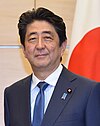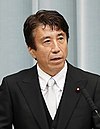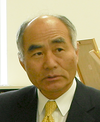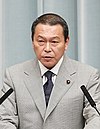Cabinet Shinzō Abe III (3rd transformation)
| Cabinet Abe III (3rd transformation) | |
|---|---|
| 97th Japanese Cabinet (3rd transformation) dai-97-dai naikaku (dai-3-ji-kaizō) |
|

|
|
|
Prime Minister Naikaku Sōri-Daijin |
Shinzo Abe |
| Legislative period | 194–195 NV (47th Abg.haus , 24th Senate ) |
| Appointed by | Emperor Akihito |
| education | 3rd August 2017 |
| The End | 1st November 2017 |
| Duration | 0 years and 90 days |
| predecessor | Cabinet Shinzō Abe III (2nd transformation) |
| successor | Cabinet Shinzō Abe IV |
| composition | |
| Party (s) | LDP - Kōmeitō coalition government ji-kō renritsu seiken |
| minister | 20th |
| State Secretaries | 5 Special Advisers to the Prime Minister 3 Parliamentary Vice-Heads of the Cabinet Secretariat 26 "Vice Ministers" 28 "Parliamentary State Secretaries" |
| representation | |
| House of Representatives | 323/475 (20.09.2017) |
| senate | 150/242 (31.10.2017) |
| Opposition leader |
|
The third Abe cabinet, which was reorganized for the third time ( Japanese 第 3 次 安 倍 第 3 次 改造 内閣 daisanji Abe daisanji kaizō naikaku ) ruled Japan under the leadership of Shinzō Abe from a cabinet reshuffle on August 3, 2017, which Abe a few weeks after the prefecture election in Tokyo carried out, until November 1, 2017. In the election, the Liberal Democratic Party had lost its majority in the Tokyo prefecture parliament with its historically worst election result, and the approval ratings of the population for the previous cabinet fell significantly due to its obviously nepotistic approach. I.a. Abe is accused of he and his wife Akie were involved in a scandal over an ultra-nationalist oriented school and kindergarten operators. At Abe's request, he received considerable discounts on a plot of land in Osaka for building an ultra-nationalist elementary school . In addition, Abe did the Ministry of Education under pressure to issue the building permit for a veterinary educational institution that had been requested by a close friend Abe.
Five ministers from the previous cabinet kept their departments, including Deputy Prime Minister Asō, Chief Cabinet Secretary Suga and Minister of Economic Affairs Sekō. Six of the new cabinet members had never been ministers before. This relatively small number of new ministers shows that Abe relied on experienced politicians for the reshuffle in order to prevent the scandal caused by the ministers' rash actions - in view of the incidents in the previous cabinet. All ministers were MPs in the National Assembly : including the Prime Minister, 16 came from the House of Representatives and four from the Senate . There were two women in the cabinet.
On September 28, 2017, Abe dissolved the House of Representatives. After the House of Representatives election on October 22, 2017 , the cabinet resigned before the election of a new prime minister on November 1, 2017 and was replaced on the same day by the fourth Abe cabinet, which was identical in personnel .
This cabinet was the first in post-war history that did not take part in a parliamentary debate, as the regular session of the Kokkai ended in June 2017 and the next regular session only began in January of the following year. In view of the Abe scandals, the opposition had requested an extraordinary session for September 28, 2017, but Parliament dissolved it on that day.
minister
| Ministerial department | Further tasks | minister | image | Parliamentary mandate (chamber, constituency, parliamentary group) |
Faction |
|---|---|---|---|---|---|
| premier | - | Shinzo Abe |  |
Ed., Yamaguchi 4, LDP | ( Hosoda ) |
|
Finances Special tasks (financial sector) |
"Overcoming Deflation" (defure dakkyaku) 1st representative of the Prime Minister ( Deputy Prime Minister ) |
Tarō Asō |  |
Ed., Fukuoka 8, LDP | Asō |
| General affairs | “Activation of women” (josei katsuyaku) [see Abenomics or “Womenomics”] 4. Representative of the Prime Minister |
Seiko Noda |  |
Ed., Gifu 1, LDP | - |
| Judiciary | - | Yōko Kamikawa |  |
Ed., Shizuoka 1, LDP | Kishida |
| Foreign Affairs | - | Tarō Kono |  |
Ed., Kanagawa 15, LDP | Asō |
| Cult and Science | “Educational Renewal ” (kyōiku saisei) 5. Representative of the Prime Minister |
Yoshimasa Hayashi |  |
Sen. (Class of 2013), Yamaguchi , LDP | Kishida |
| Social and work | "Reform of working methods" (hatarakikata kaikaku) [government initiative to limit extremely long working hours] the kidnapping problem (rachi mondai) [see kidnapping of Japanese citizens by the DPRK ] |
Katsunobu Kato | Ed., Okayama 5, LDP | Nukaga | |
| Agriculture, forestry and fishing | - | Ken Saitō |  |
Ed., Chiba 7, LDP | Ishiba |
|
Economy and industry Special tasks (organization for nuclear power compensation & reactor decommissioning) |
"Competitiveness of the industry" (sangyō kyōsōryoku) "Economic cooperation with Russia" (Roshia keizai bun'ya kyōryoku) "Economic damage from nuclear power" (genshiryoku keizai higai) |
Hiroshige Seko |  |
Sen. (Class of 2013), Wakayama , LDP | Hosoda |
| Land and Transport | "Measures for the water cycle" (mizujunkan seisaku) | Keiichi Ishii |  |
Abg., Relative North Kantō, Kōmeitō | - |
|
Environment special tasks (nuclear power disaster control) |
- | Masaharu Nakagawa |  |
Sen. (Class of 2016), Tokyo , LDP | Hosoda |
| defense | - | Itsunori Onodera |  |
Ed., Miyagi 6 | Kishida |
| Cabinet Secretariat | " Lightening the Load on the Bases in Okinawa " (Okinawa kichi futan keigen) 2. Representative of the Prime Minister |
Yoshihide Suga |  |
Ed., Kanagawa 2, LDP | - |
| reconstruction | "Comprehensive recovery from the nuclear power accident in Fukushima " (Fukushima gempatsu jiko saisei sōkatsu) | Masayoshi Yoshino |  |
Ed., Fukushima 5, LDP | Hosoda |
|
National Public Security Commission Special Tasks (Civil Protection) |
"Strengthening the toughness of the land" (kokudo kyōjinka) [government program for disaster control infrastructure ] | Hachirō Okonogi |  |
Ed., Kanagawa 3, LDP | - |
| Special Duties (Okinawa & Northern Territories ; Consumer & Food Safety; Maritime Affairs) | "Territorial conflicts " (ryōdo mondai) | Tetsuma Esaki |  |
Ed., Aichi , LDP | Nikai |
| Special tasks (declining birth rates; gender equality; cool Japan strategy; promoting intellectual property ; science & technology; space travel) | IT policy (jōhō tsūshin gijutsu (ai-tī) seisaku) "Activation of all 100 million" (ichi-oku-sō-katsuyaku) [government program for economic and social stability in the face of demographic change] |
Masaji Matsuyama |  |
Sen. (Class of 2013), Fukuoka , LDP | Kishida |
| Special tasks (economic & fiscal policy) | “Economic Renewal ” (keizai saisei) “ Human Resources Development ” (hitozukuri kakumei) “Integrated Social Security & Tax Reform” (shakai hoshō ・ zei ittai kaikaku) 3. Representative of the Prime Minister |
Toshimitsu Motegi |  |
Ed., Tochigi 5, LDP | Nukaga |
| Special tasks (regional revitalization; deregulation) | "Of city, person, work" (machi, hito, shigoto sōsei) "administrative reform" gyōsei kaikaku "national public service" (kokka kōmuin seido) |
Hiroshi Kajiyama |  |
Ed., Ibaraki 4, LDP | - |
| Minister of State (without portfolio) | Olympic & Paralympic Games Tokyo (Tōkyō orimpikku kyōgi taikai ・ Tōkyō pararimpikku kyōgi taikai) | Shun'ichi Suzuki |  |
Ed., Iwate , LDP | Asō |
Web links
- Shushō Kantei / Japanese cabinet, reshaped third cabinet Abe: Minister of State , Secretary of State (fuku-daijin) , Secretary of State (daijin seimukan) , advisor to the Prime Minister (Japanese), English translation , Chinese translation
Individual evidence
- ↑ With support rate in free fall, Abe eyes veterans for key posts in Cabinet reshuffle. In: The Japan Times . August 1, 2017, accessed on August 11, 2017 .
- ^ Right school scandal in Japan. In: The daily newspaper . March 19, 2017. Retrieved August 11, 2017 .
- ↑ Education ministry says Kake papers exist after follow-up probe, dealing a blow to Abe's Cabinet. In: The Japan Times . June 15, 2017, accessed August 11, 2017 .
- ↑ 安 倍 政 権: 国会 無視 「沈 黙 の 解散」 質疑 ゼ ロ な ら 戦 後 初 . In: Mainichi Shimbun . September 20, 2017. Retrieved November 1, 2017 (Japanese).